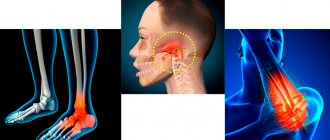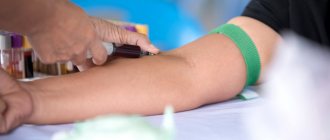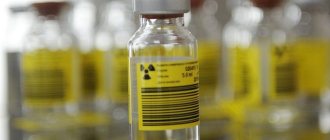When is it appointed?
A blood test for eosinophilic cationic protein is used for the initial diagnosis of allergic manifestations, as well as to identify their exacerbations and determine the severity of the pathology. In what cases can a doctor prescribe this test?
- Complaints about the presence of typical signs of allergies: sneezing, runny nose, dry cough, lacrimation, shortness of breath. As a rule, these symptoms occur after exposure to allergens: house dust, contact with animals, flowering period, etc.
- Signs of rhinitis of allergic origin. These include a runny nose, itchy nose, nasal congestion, headache, etc.
- The appearance of food allergies: swelling and itching of the mucous membranes of the oral cavity, burning in the stomach, difficulty breathing, etc.
There are signs of atopic dermatitis: itching of the skin, the appearance of a rash on the skin, dryness and flaking of the skin, etc.
It is worth noting that an analysis for eosinophilic cationic protein can also be prescribed to predict exacerbations of allergies and monitor the treatment of allergic diseases. The test can be prescribed by a pulmonologist, dermatologist, allergist or general practitioner.
What is Eosinophil Cationic Protein (ECP)?
Eosinophil Cationic Protein (ECP) is a protein with antiviral and bactericidal properties produced by eosinophils (a type of leukocyte - white blood cell) when activated.
ECP is unique to humans and primates and is secreted from eosinophil granules. Eosinophils are actively involved in the fight not only against bacteria and viruses, but also against multicellular agents (for example, parasites), and also play an important role in allergic processes occurring in the body. Eosinophils form in the bone marrow, enter the bloodstream, and then into the tissues of various organs, where they remain. When an allergic reaction develops, it is eosinophils that secrete specific proteins that have a cytotoxic effect, including ECP. However, the destructive effect of these proteins can also be directed at the body’s own tissues. Symptoms of this influence include redness, itching, spasm of smooth muscles (for example, narrowing of the bronchi). All these symptoms are manifestations of an allergic reaction. And although they are quite unpleasant, the inflammatory reaction in this case is aimed at protecting the body by limiting the pathological focus and preventing the spread of foreign agents throughout the body.
How to prepare
To obtain a reliable analysis result, you must follow several recommendations:
- The test must be taken on an empty stomach. At least 7-8 hours before the test, you must refuse food; you can only drink plain water without gas.
- Try not to overexert yourself physically or emotionally on the day of the test.
- A few hours before the test you should refrain from smoking.
- Tell your doctor about all medications you take on a regular basis. Some drugs may be excluded several days before the blood test.
Normal values
For ECP blood testing, reference values range from 0 to 24 ng/ml. Plasma protein levels are proportional to eosinophil concentration. The number of these cells changes throughout the day: in the evening the indicators increase by 15% compared to the morning, and at night - by 30%. In women, an increased level of eosinophils is often detected during menstrual bleeding, in representatives of both sexes - after drinking alcohol, heavy physical exertion, or consuming foods containing refined sugar. The range of reference values may vary among laboratories, as it depends on the research method, reagents and equipment used. Therefore, the norm indicators must be clarified in the corresponding column on the results form.
The norm and what does increasing the level mean?
To correctly determine the exact amount of ECP in the blood, it is necessary to take into account the existing standards. Indicators that vary between 0 and 24 ng/ml are considered normal.
If your score is higher than normal, this may indicate the following:
- Allergic rhinitis;
- Atopic bronchial asthma;
- Atopic dermatitis;
- Eosinophilic esophagitis, gastroenteritis, colitis;
- Allergic reaction to any food;
- The presence of parasites in the body, for example, helminths;
- Acute form of respiratory infections;
- Churg-Strauss syndrome.
Eosinophil cationic protein is one of the main mediators of eosinophils involved in the development of atopic dermatitis, asthma, allergic rhinitis and food allergies. Its concentration in blood serum is determined to assess the activity of these diseases and monitor their treatment.
Synonyms Russian
ECB.
English synonyms
Eosinophil cationic protein (ECP).
Research method
Solid-phase chemiluminescent enzyme-linked immunosorbent assay (“sandwich” method).
Units
ng/ml (nanograms per milliliter).
What biomaterial can be used for research?
Venous blood.
How to properly prepare for research?
- Do not eat for 8 hours before the test; you can drink clean still water.
- Avoid physical and emotional stress 30 minutes before the test.
- Do not smoke for 3 hours before the test.
General information about the study
Eosinophil cationic protein (ECP) is one of the main mediators of eosinophils, released from their granules in response to the interaction of the allergen and IgE immunoglobulin. It is an enzyme capable of destroying RNA (ribonuclease), which is closest in structure and function to pancreatic ribonuclease. Cytotoxicity of ECP has been demonstrated against epithelial cells, mast cells, smooth muscle cells and fibroblasts. In addition, ECP has immunomodulatory properties, as it acts on lymphocytes and stimulates a Th2-type immune response. Since eosinophils are present in the mucosa of almost all hollow organs (primarily the respiratory and gastrointestinal tracts), as well as most parenchymal organs, the release of ECP is accompanied by a variety of clinical symptoms. The role of ECP in the development of allergic diseases (bronchial asthma, allergic rhinitis, atopic dermatitis, food allergies, etc.) is especially pronounced. The concentration of ECP in blood plasma increases significantly with the development of an allergic response to an allergen entering the body. Therefore, this protein is considered as a marker of exacerbation of allergic diseases and can be used to assess the activity of their exacerbation, as well as to monitor their treatment.
The concentration of ECP in blood serum is proportional to the number of eosinophils and in a healthy person is about 7 μg/L. The level of ECP in the serum of patients with bronchial asthma increases to 15-20 μg/l. Higher rates - 60-70 µg/l - are typical for invasive helminthiases (for example, Schistosoma mansoni infection) and exacerbation of atopic dermatitis. The highest ECP values are typical for the so-called hypereosinophilic syndrome (myeloproliferative disease) and can reach 200 μg/L. In addition, an increase in the concentration of this inflammatory mediator can be used for the primary diagnosis of allergic diseases.
The degree of increase in the ECP level also makes it possible to indirectly assess the severity of an exacerbation of an allergic disease. This relationship has been most reliably established for bronchial asthma. Moreover, the level of ECP correlates with the intensity of the inflammatory reaction of the mucous membrane, but not with bronchial hyperreactivity.
As inflammation subsides and eosinophilia disappears, ECP also gradually normalizes, so the dynamics of its level is used to monitor the treatment of allergic diseases. Thus, using repeated measurements of serum ECP, the dose of inhaled glucocorticoids is titrated in the treatment of bronchial asthma. A decrease in its concentration is noted when a suitable diet is prescribed for atopic dermatitis.
It should be noted that elevated ECP concentrations are also observed in some non-allergic diseases, such as bacterial sinusitis, renal neoplasms, and respiratory syncytial virus infection, so elevated serum ECP numbers do not always indicate the development of an allergic process. Particular attention has recently been drawn to the so-called DRESS syndrome (from the English D rug Reaction with E osinophilia and S ystemic S ymptoms), which is intolerance to any drug and includes skin rash, damage to internal organs and hematological abnormalities ( including eosinophilia). Most often, DRESS syndrome develops after the administration of phenytoin, phenobarbital, carbamazepine, sulfonamides, minocycline and doxycycline. ECP concentrations are significantly elevated in patients with DRESS syndrome.
Study results should be interpreted in light of additional laboratory tests. If you suspect an allergy, you need to clarify what caused it; this can be done using allergen panels.
What is the research used for?
- For diagnosis, assessment of severity and monitoring of treatment of bronchial asthma, atopic dermatitis, allergic rhinitis, food allergies and other allergic diseases.
When is the study scheduled?
- For symptoms of atopic bronchial asthma: shortness of breath and asthma attacks that occur after contact with animal hair, house dust, tree and grass pollen, as well as other possible allergens.
- For symptoms of atopic dermatitis: itching and dry skin, eczematous skin rash, increased skin pattern, intermittent course of the disease (when it manifests itself episodically, sometimes stronger or weaker), provided that the disease occurs before the age of 2 years.
- For symptoms of allergic rhinitis: runny nose, itching, nasal congestion, sneezing, headache, loss of smell, occurring in response to any allergen (for example, tobacco smoke, pollen).
- For symptoms of food allergy: itching and swelling of the mucous membrane of the oropharynx, skin rash (most often urticaria), coughing, sneezing, nausea, vomiting, diarrhea, feeling of a rush of blood to the face, abdominal pain, hypotension, heart rhythm disturbances that occur in response to eggs, milk, tree nuts, fish, shellfish, wheat, or other foods.
What do the results mean?
Reference values: 0 - 24 ng/ml.
Reasons for increasing ECP level:
- seasonal allergic rhinitis;
- atopic bronchial asthma;
- atopic dermatitis;
- eosinophilic esophagitis, gastroenteritis, colitis;
- food allergies;
- invasive helminthiases (Ascaris lumbricoides, Taenia solium);
- aspirin asthma;
- acute respiratory infections;
- polyposis of the paranasal sinuses;
- Churg-Strauss syndrome;
- hypereosinophilic syndrome;
- phenytoin, phenobarbital, carbamazepine, co-trimoxazole, sulfonylureas (glibenclamide, glimepiride), minocycline and doxycycline, penicillin and non-steroidal anti-inflammatory drugs.
A decrease in ECP level has no diagnostic value.
What can influence the result?
- Some medications (eg, aspirin and doxycycline) may be associated with eosinophilia and increased levels of eosinophil cationic protein.
What may affect the results of the study?
Please note that in some cases, eosinophil cationic protein values may be unreasonably high. For example, this can occur while taking certain medications: non-steroidal anti-inflammatory drugs, co-trimoxazole, phenobarbital, carbamazepine, sulfonylurea-based drugs (glibenclamide, glimepiride), minocycline and doxycycline, penicillin preparations. In addition, an increased concentration of eosinophilic cationic protein can occur with helminth infection, bacterial sinusitis, kidney tumors, etc. Therefore, the result of the analysis should be evaluated together with data from additional laboratory and instrumental studies.
To correctly decipher the analysis and prescribe treatment (if necessary), you need to contact your doctor. Be healthy!
References
- Izmailovich, M.R., Gazalieva, M.A., Glushkova, N.E. et al. Eosinophilic cationic protein in patients with allergic rhinitis. Science and healthcare, 2021. - T. 22. - P. 39-47.
- Karnaushkina, M.A., Fedosenko, S.V., Danilov, R.S. et al. Eosinophilic cationic protein as a non-invasive marker of the nature of the inflammatory response in patients with chronic obstructive pulmonary disease. Bulletin of Siberian Medicine, 2021. - T. 19. - P. 59-66.
- Ostroumova, O.D., Shakhova, E.Yu., Kochetkov, A.I. Drug-induced eosinophilia. Safety and risk of pharmacotherapy, 2021. - T. 7. - No. 4. - P. 176-189.
- Bronchial asthma. Clinical guidelines, 2021. - 97 p.
- Bystrom, J., Kawa, A., Bishop-Bailey, D. Analyzing the eosinophil cationic protein—a clue to the function of the eosinophil granulocyte. Respir Res, 2011. - Vol. 12(1). - P. 10.
Treatment of abnormalities
The ECP blood test is used in clinical practice in the diagnosis and monitoring of allergic diseases. Its results are used to determine the inflammatory process and evaluate the effectiveness of the applied therapeutic measures. If the obtained indicators exceed the norm, then to clarify the diagnosis and prescribe treatment, you need to consult a doctor - an allergist, pulmonologist, dermatologist, gastroenterologist, pediatrician. To avoid a physiological increase in ECP in the blood, it is necessary to properly prepare for blood donation: stop smoking and drinking alcohol, take the required break from eating, and perform the procedure in the morning.









